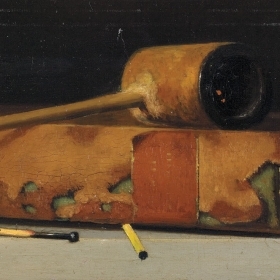If you’re missing museums closed due to the pandemic, you’re not alone. Even the staff of the Davis Museum, which shut its doors last March, have been separated from the artwork they usually see every day. But now there’s a solution—for them and for people around the globe: a new high-resolution 3D model of the Davis galleries.
“Even for us as staff members, I think we were surprised at our own emotional response to this,” says Amanda Gilvin, the Sonja Novak Koerner ’51 Senior Curator of Collections and assistant director of curatorial affairs at the Davis. “We’re not able to be in the galleries as usual, and it gave us a lot of pleasure.” But even more critical, it has allowed professors and their students to have access to the artwork for classes and individual study.
The new model is thanks to the pro bono work of Luke Hollis, CEO of Archimedes Digital in Cambridge, Mass. The firm is known for its high-end 3D scans of cultural heritage sites around the world, such as the ancient Egyptian tomb of Menna at Thebes. Grounded by the pandemic, Archimedes Digital offered its resources to institutions in Boston. Hollis made hundreds of very high-resolution 3D photographs of the Davis galleries, which were then stitched together.
A digital visitor can now “walk” through each level of the Davis galleries, clicking on white circles (showing positions of the camera) and moving close to works of art. Where labels and wall text are not visible, another click brings up a caption.
So far this academic year, more than 700 students in nearly 50 classes have “visited” the galleries. Gilvin points to the possibilities of the digital galleries. “You can sure get from one place to another faster,” she says, which is particularly helpful when comparing two works on separate floors. The model also allows the Davis to welcome visitors from far and wide. Already Gilvin has given remote talks at Skidmore and Wheaton colleges—and used the model for 100 percent virtual tours.
You can find the 3D tour of the Davis here. To request a guided tour (including in American Sign Language or with verbal description), contact Arthurina Fears, curator of education and programs, at afears@wellesley.edu. The Davis also has a variety of virtual exhibits on display at www.wellesley.edu/davismuseum.








We ask that those who engage in Wellesley magazine's online community act with honesty, integrity, and respect. (Remember the honor code, alums?) We reserve the right to remove comments by impersonators or comments that are not civil and relevant to the subject at hand. By posting here, you are permitting Wellesley magazine to edit and republish your comment in all media. Please remember that all posts are public.